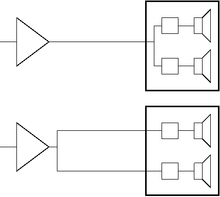| Revision as of 07:44, 13 January 2014 editOhconfucius (talk | contribs)Autopatrolled, Extended confirmed users, Pending changes reviewers328,951 edits expand, with cite, Script-assisted fixes: per MOS:NUM, MOS:CAPS, MOS:LINK← Previous edit | Revision as of 07:45, 13 January 2014 edit undoOhconfucius (talk | contribs)Autopatrolled, Extended confirmed users, Pending changes reviewers328,951 edits WLNext edit → | ||
| Line 4: | Line 4: | ||
| ]s]] | ]s]] | ||
| '''Bi-wiring''' is a means of connecting a ] to an audio ], primarily used in ] systems. Normally, there is one pair of connectors on a loudspeaker and a single cable (two conductors) runs from the amplifier output to the terminals at the loudspeaker housing. From this point, connections are made to the loudspeaker drivers – most often through ] networks. In bi-wiring, each loudspeaker has two pairs of connectors and two cables are run from the amplifier output to the speaker cabinet – one for the high frequency or ] driver and one for the low frequency driver (through two separate crossover networks). The purported advantage of this is that there is less interaction between high and low frequency signals. | '''Bi-wiring''' is a means of connecting a ] to an audio ], primarily used in ] systems. Normally, there is one pair of connectors on a loudspeaker and a single cable (two conductors) runs from the amplifier output to the terminals at the loudspeaker housing. From this point, connections are made to the loudspeaker drivers – most often through ] networks. In bi-wiring, each loudspeaker has two pairs of connectors and two cables are run from the amplifier output to the speaker cabinet – one for the high frequency or ] driver and one for the low frequency driver (through two separate crossover networks). The purported advantage of this is that there is less ] signals. | ||
| It is overlooked that both ways (connecting the two drivers at either the amplifier's end, or internally the speaker cabinet) of making speaker connections are electrically equivalent. This has led some to sarcastically refer to the practice as "buy-wiring", implying it is nothing more than a marketing gimmick for expensive speaker wire.<ref>{{cite journal|url=http://www.theaudiocritic.com/downloads/article_1.pdf | It is overlooked that both ways (connecting the two drivers at either the amplifier's end, or internally the speaker cabinet) of making speaker connections are electrically equivalent. This has led some to sarcastically refer to the practice as "buy-wiring", implying it is nothing more than a marketing gimmick for expensive speaker wire.<ref>{{cite journal|url=http://www.theaudiocritic.com/downloads/article_1.pdf | ||
Revision as of 07:45, 13 January 2014


Bi-wiring is a means of connecting a loudspeaker to an audio amplifier, primarily used in hi-fi systems. Normally, there is one pair of connectors on a loudspeaker and a single cable (two conductors) runs from the amplifier output to the terminals at the loudspeaker housing. From this point, connections are made to the loudspeaker drivers – most often through crossover networks. In bi-wiring, each loudspeaker has two pairs of connectors and two cables are run from the amplifier output to the speaker cabinet – one for the high frequency or tweeter driver and one for the low frequency driver (through two separate crossover networks). The purported advantage of this is that there is less interaction between high and low frequency signals.
It is overlooked that both ways (connecting the two drivers at either the amplifier's end, or internally the speaker cabinet) of making speaker connections are electrically equivalent. This has led some to sarcastically refer to the practice as "buy-wiring", implying it is nothing more than a marketing gimmick for expensive speaker wire.
One possible explanation may be that the increased amount of cable (i.e. twice the amount) is providing a lower electrical resistance and therefore allowing more current through to the loudspeaker. The same effect could therefore be achieved by just using a thicker cable.
However, there are many audiophiles who fully accept that bi-wiring brings an audible improvement over standard single cabling. For example, John Atkinson, writing in Stereophile, observed "subtle but important" differences, particularly in reducing treble hardness and improvement in bass control in one review. Bi-wiring should not be confused with the hi-fi practice of bi-amping, which brings a true separation of signal frequencies.
References
- Peter Aczel (Fall 2000). "The Ten Biggest Lies in Audio" (PDF) (26). The Audio Critic. Retrieved 3 June 2009.
{{cite journal}}: Cite journal requires|journal=(help) - Atkinson, John (5 September 1995). "Celestion SL700 loudspeaker", Stereophile, pg.3